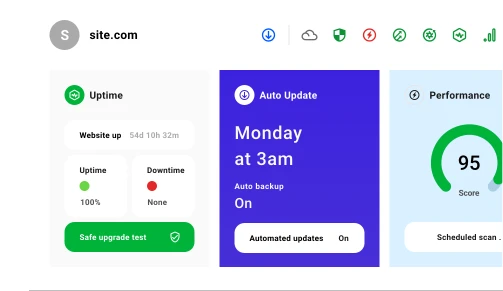Website uptime is crucial. It refers to the time your website is accessible and running smoothly. A site with high uptime provides a better user experience, helps retain visitors, and improves search engine rankings. Downtime, on the other hand, can hurt your business by turning away potential customers.
Imagine a visitor trying to access your website but finding it unavailable. They will likely leave and never return, which means lost opportunities and revenue. Consistent uptime ensures that your site remains accessible whenever users need it. This reliability builds trust and strengthens your brand.
Staying informed about website uptime is essential for business success. This guide will help you understand its importance and provide the tools and tips you need to ensure your website remains up and running efficiently.
Understanding Website Uptime
Website uptime refers to the time your website is online and accessible to users. High uptime means your site is always available, providing a reliable experience for visitors. Uptime is usually measured as a percentage. For example, 99.9% uptime means your site is down for only a short period each month.
Maintaining high uptime is essential for several reasons. First, it keeps your visitors happy. People expect websites to be available whenever they need them. If your site is down, visitors may quickly leave and find another site that meets their needs. This not only affects user satisfaction but also leads to lost business opportunities.
Second, search engines favor websites with high uptime. Sites that are frequently down may be penalized in search rankings. This can hurt your visibility and make it harder for people to find your site. High uptime helps improve your search engine rankings, driving more traffic to your site.
Lastly, high uptime builds trust. Users are more likely to return to a site they know they can count on. This reliability enhances your reputation and helps build a loyal customer base.
Common Causes of Downtime
Several factors can cause website downtime. Understanding these causes can help you take steps to prevent them.
1. Server Issues: Problems with your web server are a common cause of downtime. Servers can go down due to hardware failures or software issues. Regular maintenance and choosing a reliable hosting provider can minimize these risks.
2. High Traffic: A sudden spike in traffic can overwhelm your server, causing your site to go down. This often happens during sales events or after a viral post. Using scalable hosting solutions can help manage high traffic levels.
3. Cyber Attacks: Hackers can bring your site down through various attacks, like Distributed Denial of Service (DDoS) attacks. These attacks flood your site with traffic, making it impossible for real users to access it. Implementing strong security measures can reduce the risk of cyber attacks.
4. Software Updates: Sometimes, installing updates to your website software or plugins can cause compatibility issues that lead to downtime. Testing updates in a controlled environment before applying them to your live site can help avoid this problem.
5. Human Error: Mistakes by you or your team can also cause downtime. This can include accidentally deleting files or making incorrect configurations. Having backup systems and proper training can help minimize human error.
Tools to Monitor Uptime
Monitoring your website’s uptime is crucial to ensure it remains accessible. Several tools can help track and alert you to any downtime. These tools provide real-time updates and detailed reports, allowing you to take immediate action.
1. Uptime Robot: This tool offers free and paid options to monitor your site. It checks your website at regular intervals and notifies you via email or SMS if it detects downtime. The detailed logs help you understand the reasons for any outages.
2. Pingdom: A popular monitoring service that provides a comprehensive view of your website’s performance, including uptime. It alerts you instantly when your site goes down, helping you resolve issues promptly.
3. StatusCake: This tool offers in-depth monitoring of your website’s uptime, speed, and performance. It provides instant notifications through various channels like email, SMS, and even integration with apps like Slack.
4. Site24x7: This tool not only monitors uptime but also tracks website performance, server health, and application performance. It offers detailed insights and instant alerts, making it easier to troubleshoot issues.
5. New Relic: A more advanced tool that provides detailed analytics on website uptime, performance, and user experience. It helps you identify bottlenecks and optimize your site’s performance to ensure high uptime.
Using these tools can help you stay proactive. Being aware of any issues in real-time allows you to address them quickly, ensuring your site remains accessible to users.
Best Practices to Ensure High Uptime
Ensuring high uptime involves implementing best practices that keep your website running smoothly. Here are steps to help you achieve this:
1. Choose a Reliable Hosting Provider: Your web host plays a significant role in uptime. Select a provider known for reliability and excellent support. Look for hosts that offer uptime guarantees.
2. Regular Maintenance: Schedule regular maintenance to update software, plugins, and address any potential vulnerabilities. This helps keep your site secure and functional.
3. Implement Backups: Always have a backup plan. Regularly back up your website data to restore it quickly in case of an outage. Automated backups can simplify this process.
4. Use a Content Delivery Network (CDN): A CDN can distribute your content across multiple servers globally. This reduces the load on your main server and ensures faster access for users worldwide.
5. Monitor Uptime: Use uptime monitoring tools to get real-time alerts about any downtime. This allows you to take immediate action to resolve issues.
6. Security Measures: Protect your website from cyber-attacks by using strong security measures. Regular updates, firewalls, and malware scanning can prevent many threats.
7. Scalable Infrastructure: As your traffic grows, ensure your infrastructure can handle the load. Scalable hosting solutions can accommodate traffic spikes without compromising uptime.
Benefits of Partnering with Eight Hats: A Conclusive OverviewConclusion
Website uptime is critical for maintaining a positive user experience and growing your online presence. High uptime ensures that your site is accessible, which helps build trust with your users and improves your search engine rankings. Understanding uptime, and common downtime causes and using the right tools can keep your site running smoothly.
Stay proactive and monitor your site’s performance to address issues before they become major problems. This ensures that your site remains accessible whenever users need it.
Ready to enhance your website’s uptime and performance? Contact Eight Hats today to learn how our exceptional Lafayette web development, hosting, and support services can help keep your site running seamlessly!




